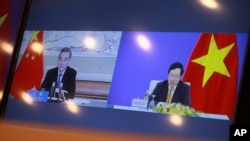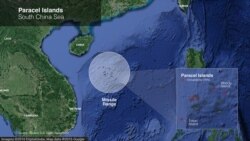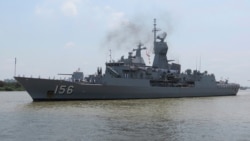Officials from Vietnam and China met this week after months of maritime disputes, including a sunken boat and missile tests.
Chinese Defense Minister Wei Fenghe met Vietnamese ambassador to China Phạm Sao Mai in Beijing.
Wei said at the meeting China hopes to “strengthen unity, closely cooperate and appropriately handle disputes” with Vietnam in the face of “global changes,” according to a statement on the ministry's website.
Coolig China - Vietnam tensions
Asia political experts say the two sides are seeking to cool tensions between the Asian neighbors to prevent an escalation of their recent conflicts at sea.
“It’s an attempt to dial down, I think, tensions, not end them but to dial down tensions specifically,” said Carl Thayer, Southeast Asia-specialized emeritus professor at the University of New South Wales in Australia.
Although the two Communist party-run states are known for dramatic ups and downs in their relations, the first eight months of 2020 tested the downside with a series of incidents in the contested South China Sea.
In April a Chinese survey vessel sank a Vietnamese fishing boat. Two months later, a Chinese survey ship passed within 200 nautical miles (370 kilometers) of Vietnam’s coast in an exclusive economic zone or EEZ. In August the Chinese military test-fired two missiles near the Paracel Islands, a South China Sea archipelago controlled by Beijing but vehemently contested by Vietnam, Chinese media reports say.
“They rammed the Vietnamese fishing vessel, they sent the (survey ship) Haiyang Dizhi No. 8 to Vietnam’s EEZ, and I think that’s what really drove the Vietnamese up the wall,” said Yun Sun, East Asia Program senior associate at the Stimson Center think tank in Washington.
Vietnam for its part angered China with a March 30 note to the United Nations rebutting the legal basis for Beijing’s maritime claims. China cites historical usage records to back its maritime claims.
Vietnam and China contest sovereignty over the 3.5 million-square-meter waterway that’s prized for energy reserves and fisheries. Brunei, Malaysia, the Philippines and Taiwan dispute the Chinese claims as well. China has strengthened its control over the past decade by landfilling tiny islets for military use.
US influence in Asia
Defense officials in Beijing hope China and Vietnam will oppose “hegemonism” and “interventionism,” China's foreign ministry statement added.
Chinese officials want the defense minister’s talks with Vietnam’s ambassador to cast China as a collaborator among Asian governments, said Alexander Vuving, professor at the Daniel K. Inouye Asia-Pacific Center for Security Studies in Hawaii. Lack of willingness to cooperate would make China’s former Cold War foe the United States more influential in Asia.
“China wants to show the world that they are able to cooperate, and they are actually cooperating with smaller neighbors,” said Vuving.
China hopes particularly to bolster its image around Asia after U.S. Secretary of State Michael Pompeo’s tough talk against it, which Thayer describes as an “onslaught.” Pompeo said in July the United States would protect Asian countries threatened by Beijing, including in the South China Sea.
The U.S. Navy regularly passes ships into the sea to show it’s open internationally despite Chinese claims to about 90% of it.
China sees U.S. movement in the sea as intervention by an outside power. Australia, Japan, and the United States have separately offered military aid to Vietnam over the past four years.
China is Vietnam’s top trading partner as well as a key source of raw materials for Vietnam’s all-important manufacturing sector. “For the Vietnamese, the agenda is to maintain sort of a friendly relationship with China,” said Vuving. “They badly need that, so at least at the minimum they have to keep the channels with China.”
In the longer term, China hopes to persuade Vietnam into joining its $1 trillion Belt-and-Road initiative, he added.
The seven-year-old global project aims to build new infrastructure to foster trade routes around Eurasia. Vietnam, where citizens distrust China over centuries of territorial disputes and the ongoing South China Sea conflict, has resisted supporting the project.








